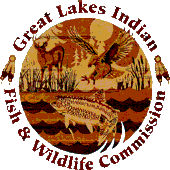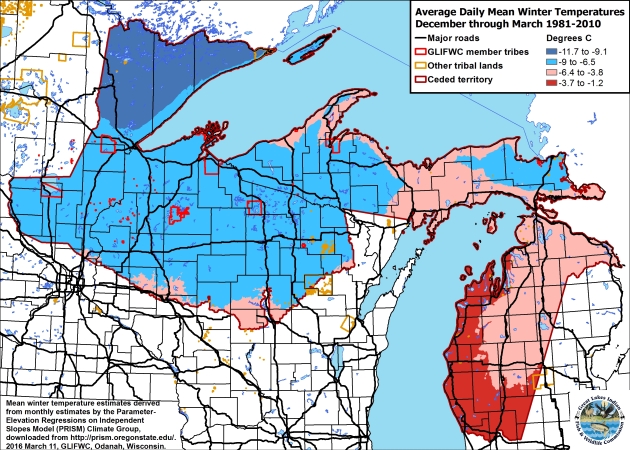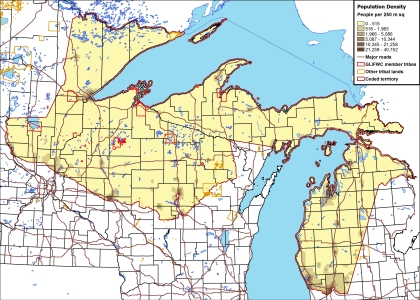RISK MAPS FOR FOREST PESTS OF MAJOR CONCERN IN THE OJIBWE CEDED TERRITORIES
GAAGAAGIMIZH, GAAGAAGIWANZH
Gaagaagimizh (eastern hemlock) is an iconic tree of the eastern hardwood-conifer forest. It's range extends from the east coast of North America, south through the Appalachians and west through northern Michigan and Wisconsin, barely making it into extreme northeastern Minnesota. Along with sugar maple and (east of the central UP and eastern Wisconsin) American beech, gaagaagimizh was once a dominant tree of the upland hardwood forests. Massive logging in the late 1800s and early 1900s decimated many stands, but gaagaagimizh is still widespread and locally common across most of the Ceded Territory.
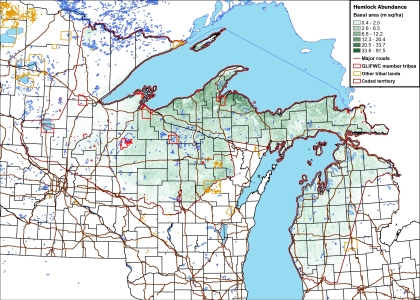
Gaagaagimizh is a highly shade-tolerant, slow-growing, long-lived tree. Trees may may take 250-300 years to mature and live for 800 years or more, potentially reaching more than 6 feet in diameter (dbh) and 175 feet tall (Godman and Lancaster 1990). Gaagaagimizh does the best in cool, humid woods, and forms pure stands around borders of imbedded wetlands, in ravines, and on cool north-facing slopes. Little else grows in the deep shade created by a dense stand of gaagaagimizh.
Gaagaagimizh stands provides excellent winter cover for a wide variety of birds and mammals. Porcupines can often be found hanging out in the canopy of gaagaagimizh in the winter, getting both food and shelter from the dense foliage. Stands along streams keep their waters cool through the summer, providing excellent habitat for brook trout.
The risk map for hemlock woolly adelgid introduction and survival was calculated using the data for hemlock abundance shown above, along with the average daily mean winter temperatures for December through March and human populations density. Average daily mean winter temperature for these four months was chosen because it was found to have the strongest relationship with HWA overwintering mortality of seven indices of winter temperature (Eschtruth et al. 2013).
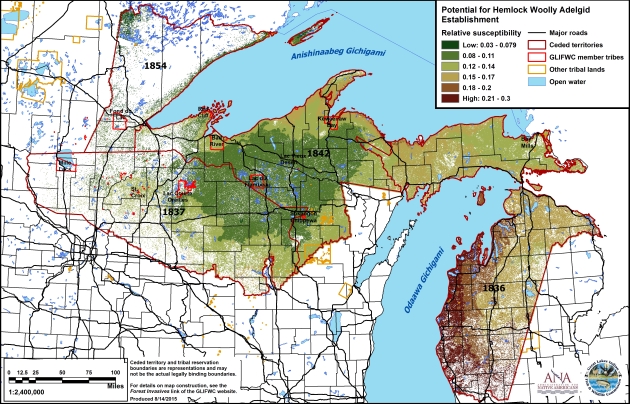
Learn More about the Hemlock Woolly Adelgid
Biology and control of hemlock woolly adelgid
http://www.dcnr.state.pa.us/cs/groups/public/documents/document/dcnr_20029649.pdf
This very nicely written 21-page report by the Forest Health Technology Enterprise Team of the USDA-Forest Service (Havill et al. 2014) summarizes the ecological importance of hemlock, the HWA’s biology, status and impact, and the ongoing efforts to control the HWA (especially using biocontrol insects) and save eastern North America’s great hemlock forests. Includes a fair amount of technical information yet is quite readable, with lots of great photos.
References
Eschtruth, A. K., R. A. Evans, and J. J. Battles. 2013. Patterns and predictors of survival in Tsuga canadensis populations infested by the exotic pest Adelges tsugae 20 years of monitoring. Forest Ecology and Management 305: 195-203.
Godman, R. M. and K. Lancaster. 1990. Hemlock. In: Volume I: Conifers. Silvics of North America. USDA Forest Service Agriculture Handbook 654. R. M. Burns and B. H. Honkala, Technical Coordinators. 877 p. http://www.na.fs.fed.us/pubs/silvics_manual/Volume_1/tsuga/canadensis.htm (March 11, 2016).
